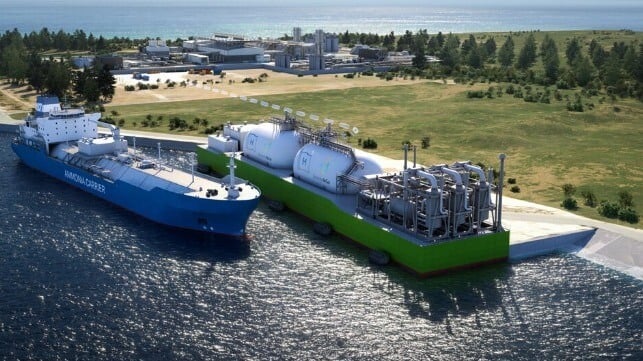Germany's First Floating Hydrogen Terminal to Supply Industrial Regions
Key Ideas
- Deutsche ReGas and Hoegh-LNG are collaborating to develop the world's first floating import terminal for the conversion of green ammonia to green hydrogen.
- The terminal, H2-Import-Terminal Lubmin, is expected to be operational by early 2026, aiming to decarbonize industrial regions in eastern and southern Germany.
- Hoegh LNG's innovative cracking technology embedded in a barge will enable the conversion and decarbonization of FSRU’s in Germany, providing cost-competitive hydrogen in the near future.
- Around 30,000 tons of hydrogen per year will be produced, feeding into Germany's hydrogen core network to support industrial decarbonization and serve as a model for global sustainability efforts.
Plans have been unveiled for the construction of the first floating terminal aimed at handling the importation of hydrogen in Germany. Deutsche ReGas and Hoegh-LNG, known for their contribution in developing LNG import terminals to replace Russian supplies, have joined forces to establish the groundbreaking 'H2-Import-Terminal Lubmin.' This terminal will be a pioneering facility globally, dedicated to converting green ammonia into green hydrogen on an industrial scale. The terminal is set to commence operations in early 2026, with the primary objective of supporting the decarbonization of industrial zones in eastern and southern Germany. The collaboration between the two companies signifies a crucial step towards achieving sustainable energy goals in the region.
The innovative aspect of this project lies in Hoegh LNG's development of a green ammonia cracker technology to be integrated into a barge, enabling the conversion and decarbonization of Floating Storage Regasification Units (FSRU’s) in Germany. This technology is expected to facilitate the provision of cost-competitive hydrogen within a few years, a key element in the industrial decarbonization strategy. The partnership between Deutsche ReGas and Hoegh-LNG encompasses the utilization of existing expertise, technology, and infrastructure elements, built upon the success of previous LNG terminal projects.
The operation is estimated to produce approximately 30,000 tons of hydrogen annually, which will be integrated into Germany's hydrogen core network via the Deutsche ReGas Terminal in the port of Lubmin. The significance of this initiative is underscored by Germany's status as an early adopter of hydrogen as an alternative fuel in its industrial sector. This ambitious project aims to serve as a blueprint for global decarbonization efforts, particularly targeting challenging industries to transition from fossil fuels and reduce emissions.
Topics
Maritime
Energy Transition
Green Energy
Infrastructure Development
Ammonia Technology
Industrial Decarbonization
Latest News
